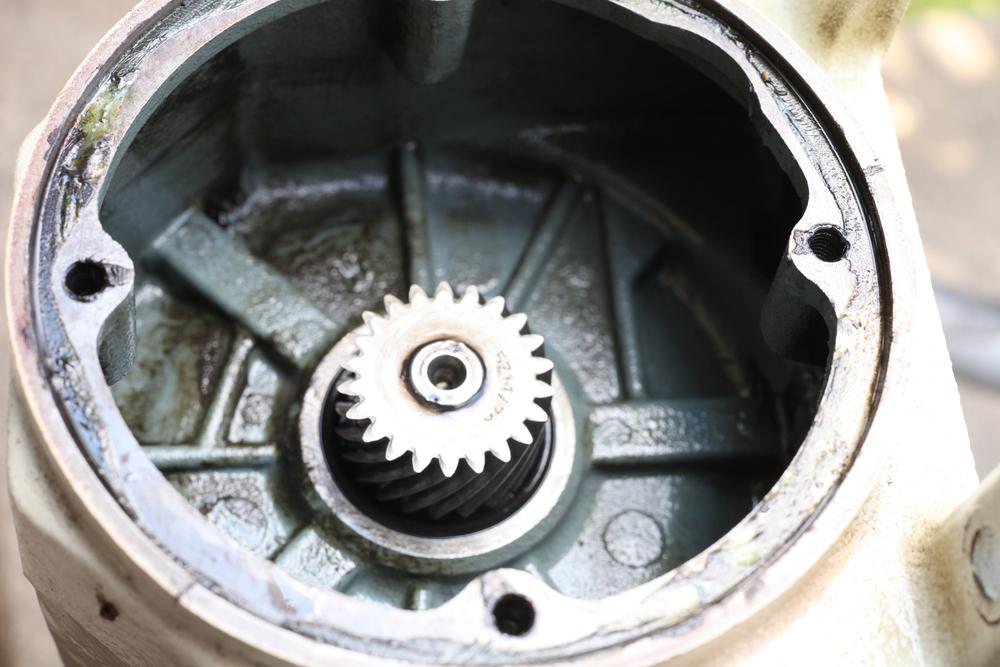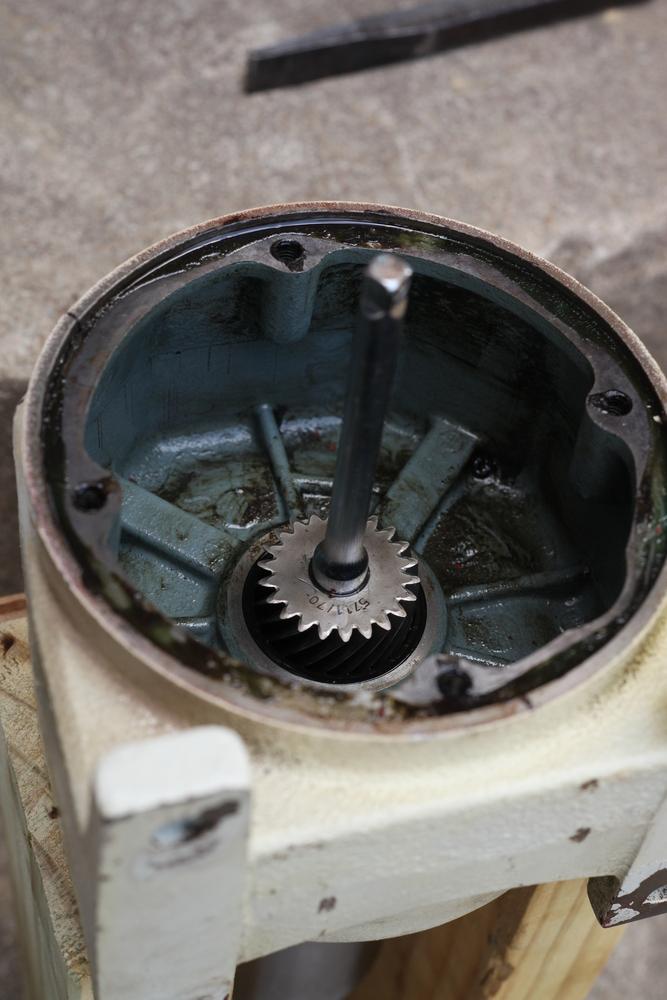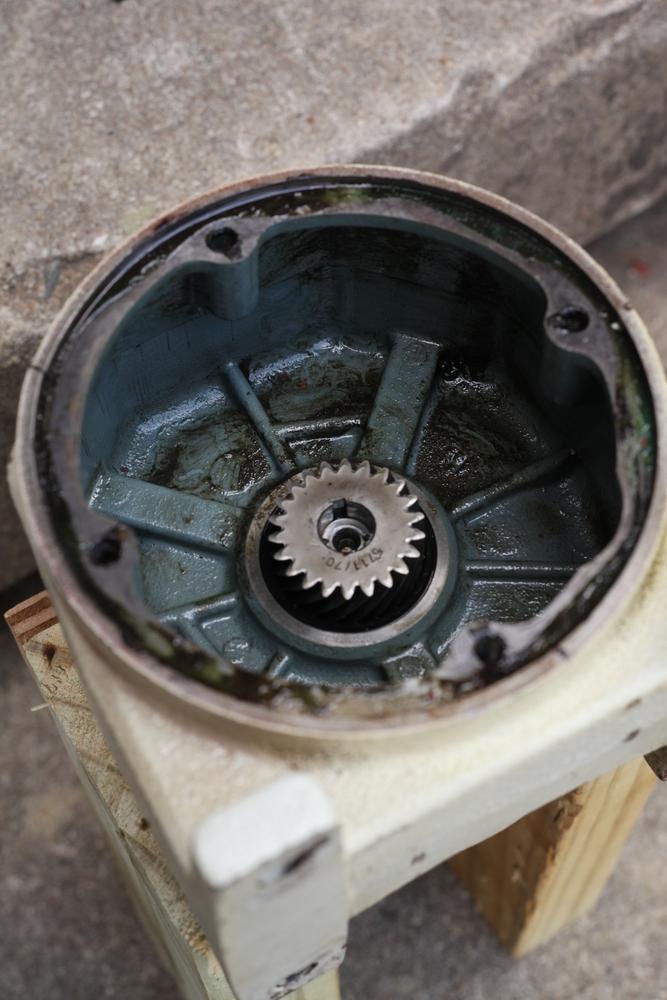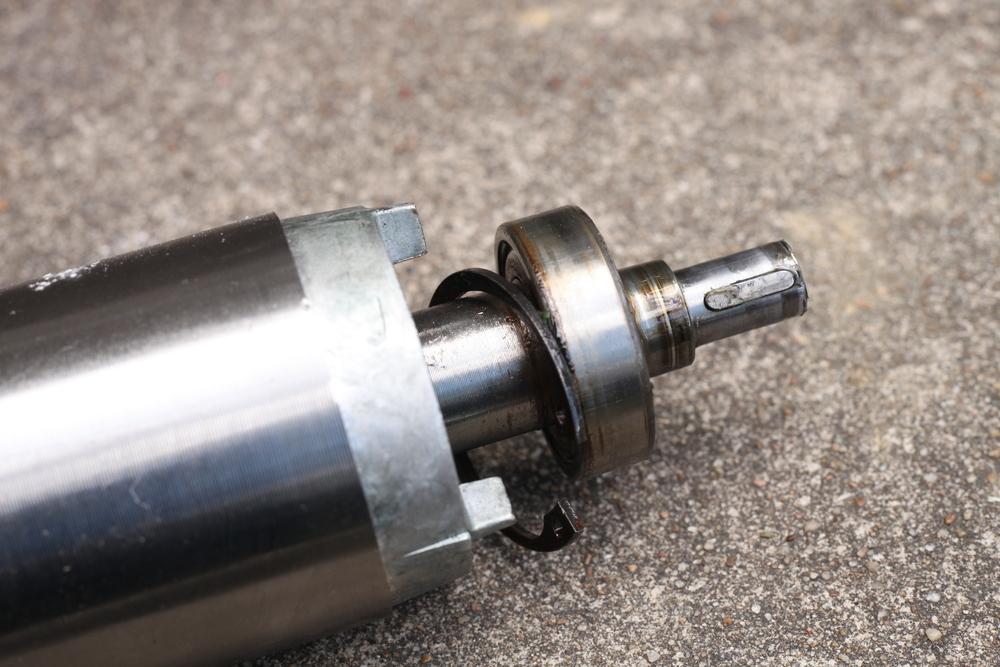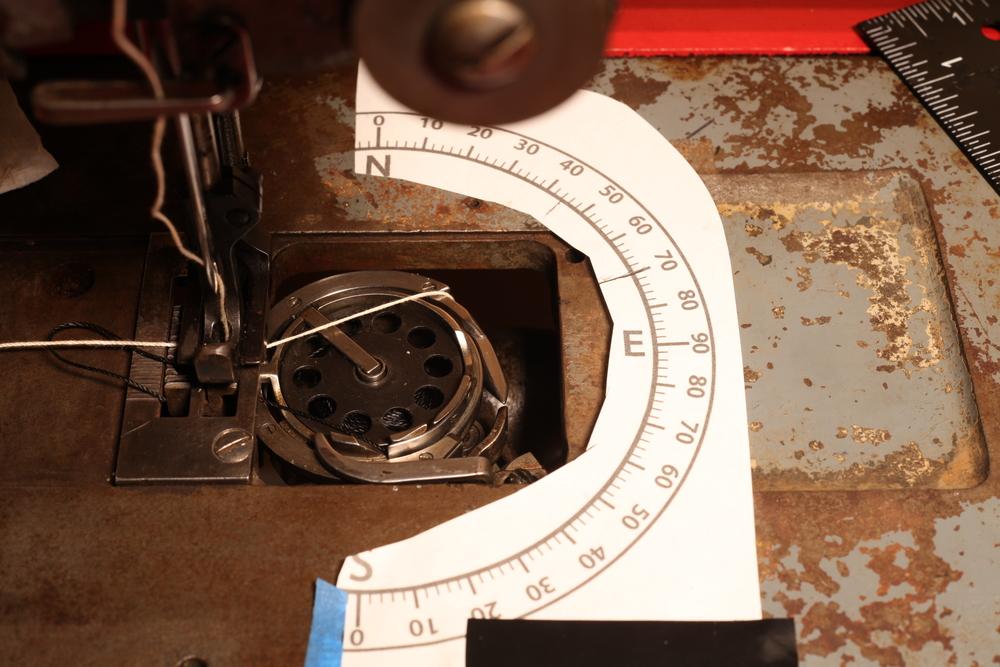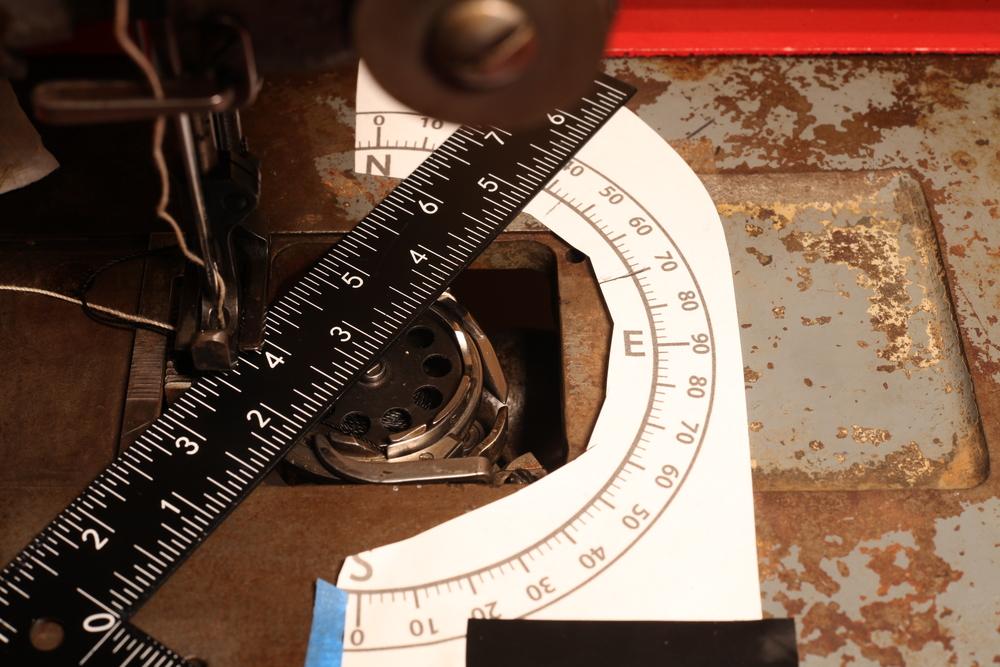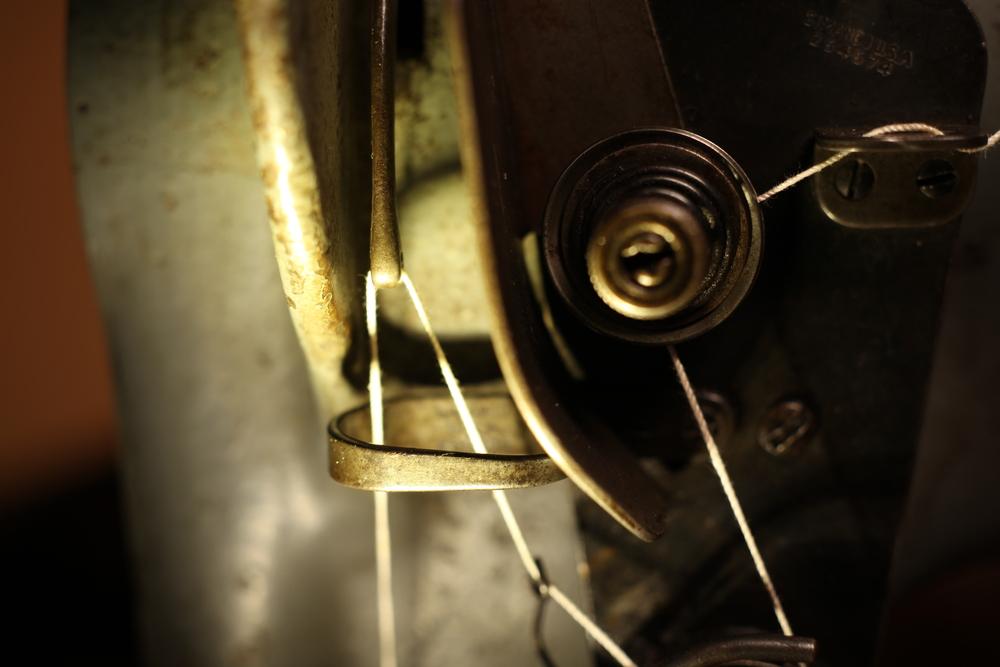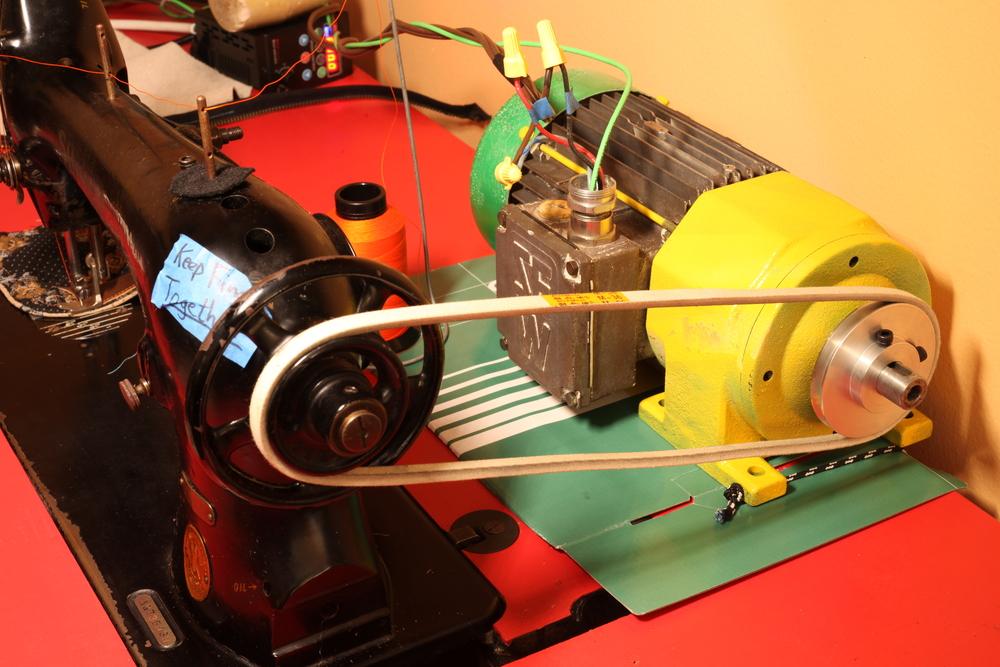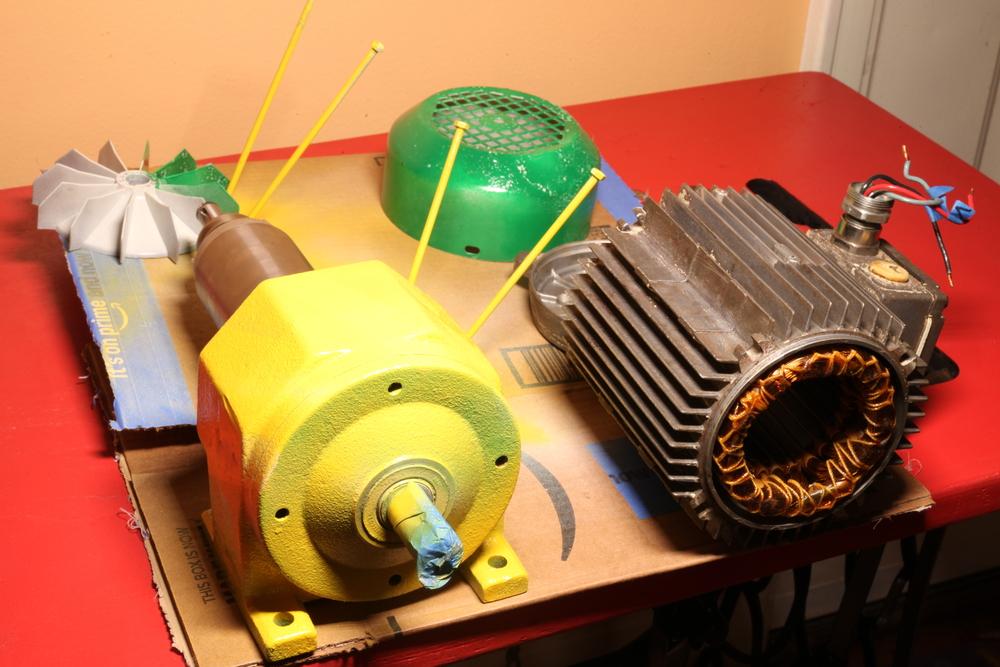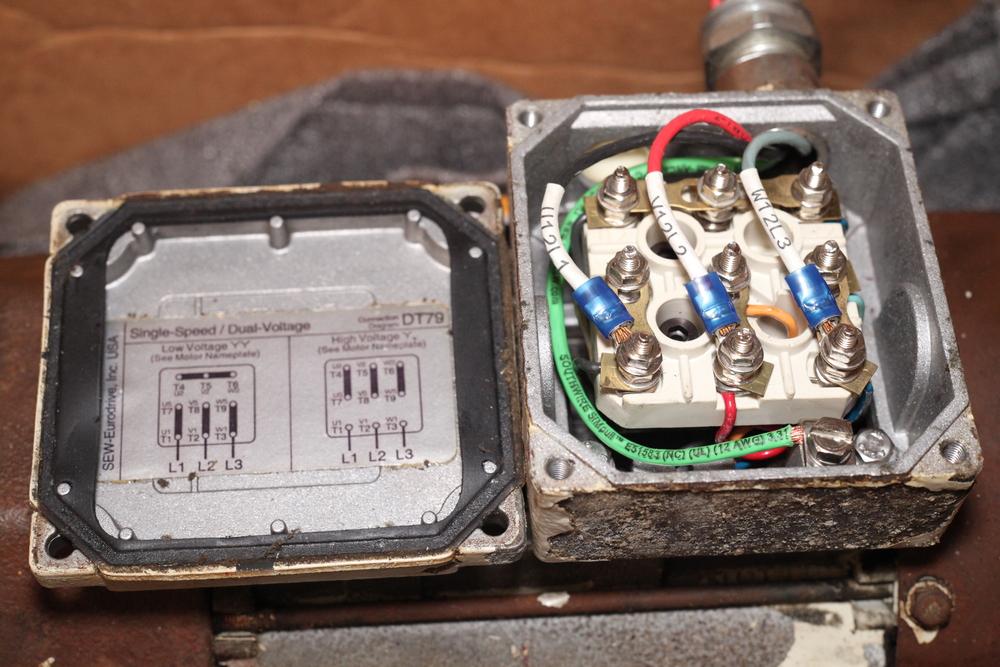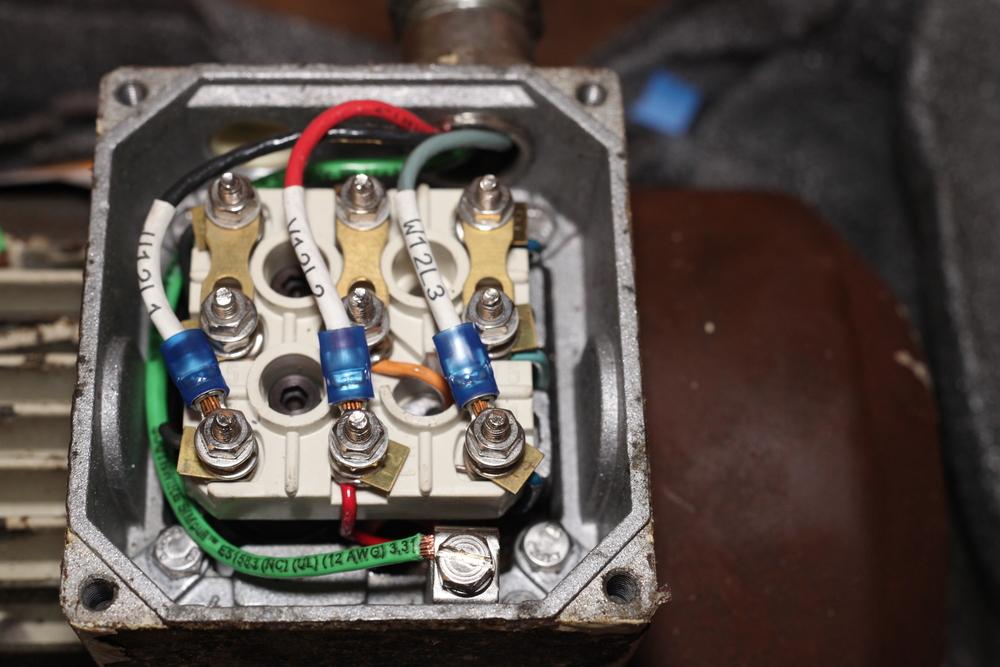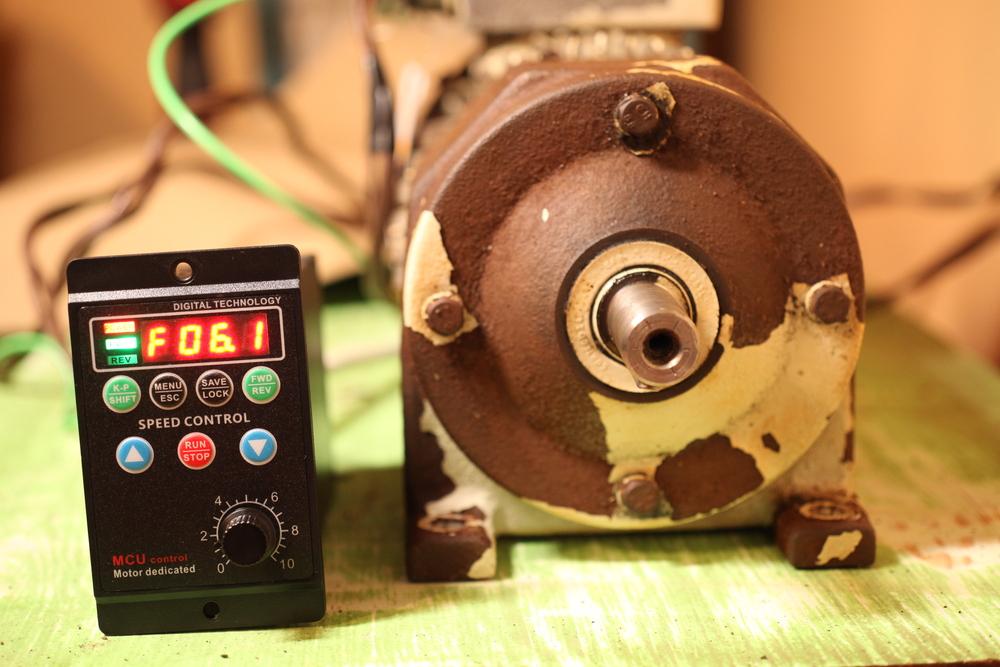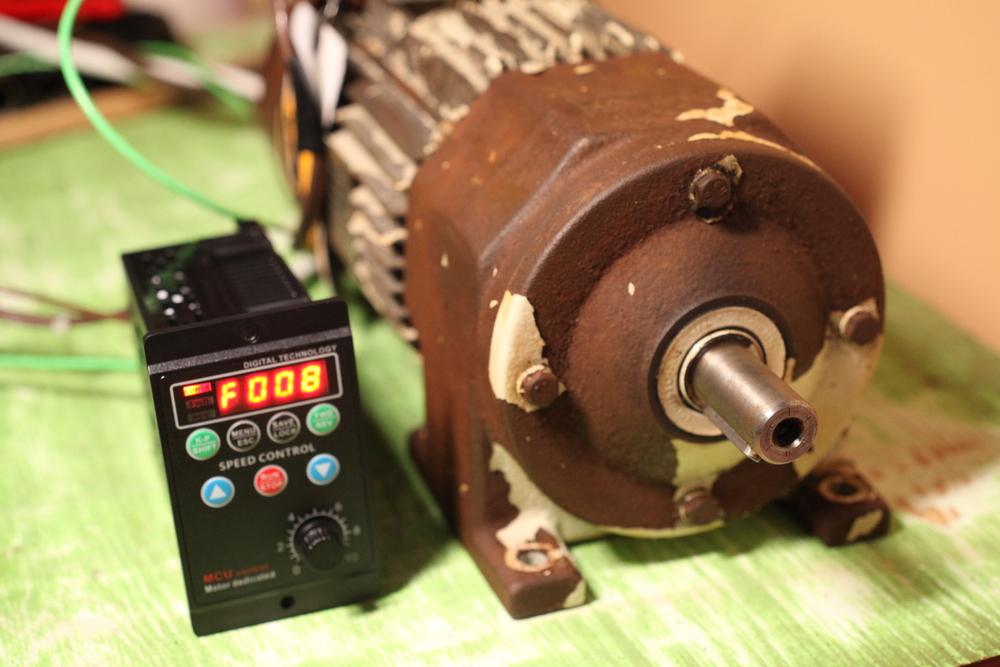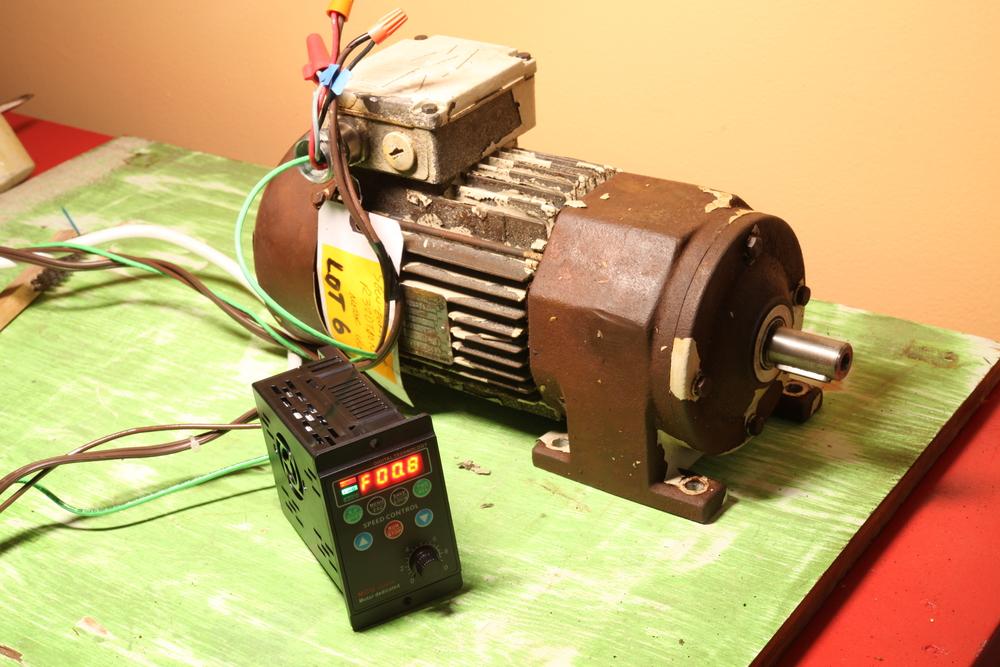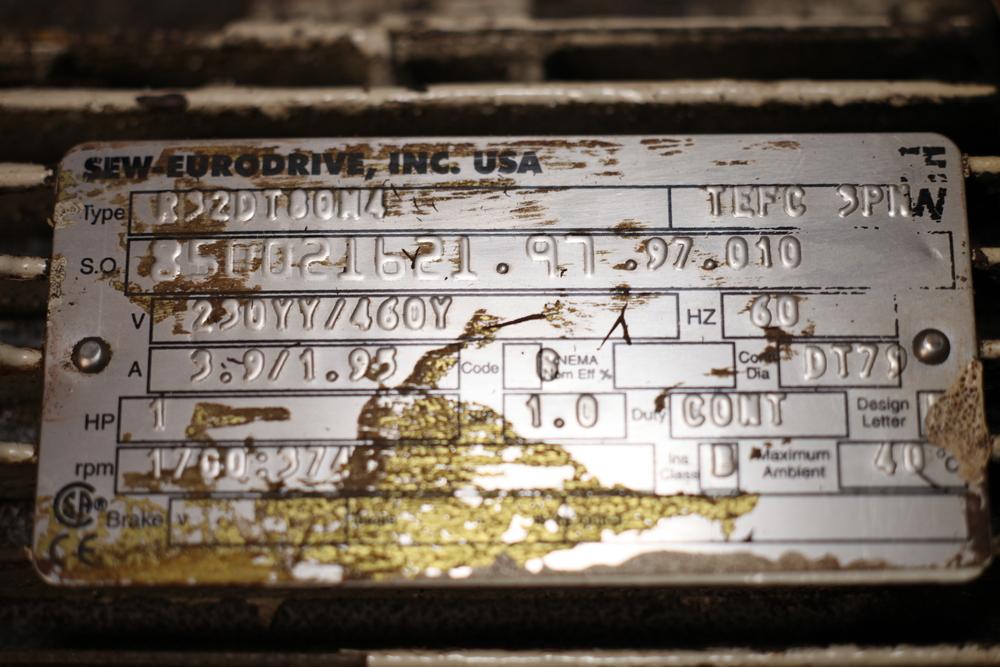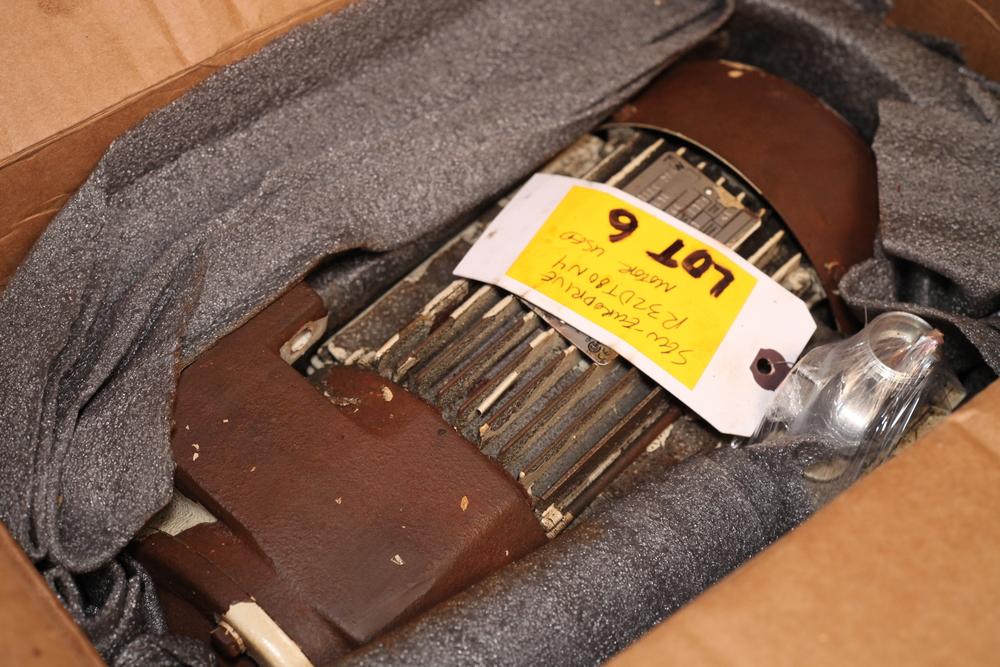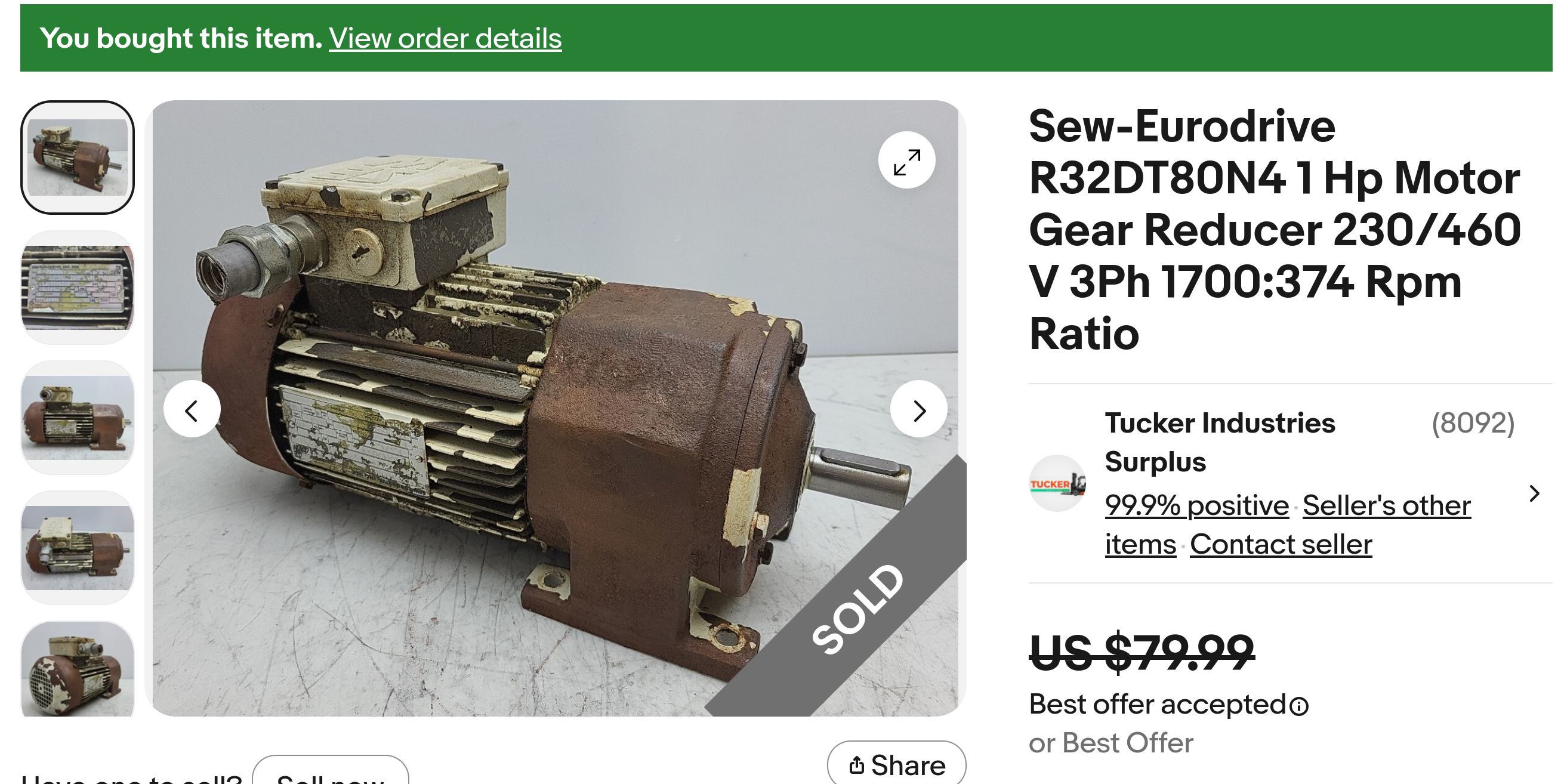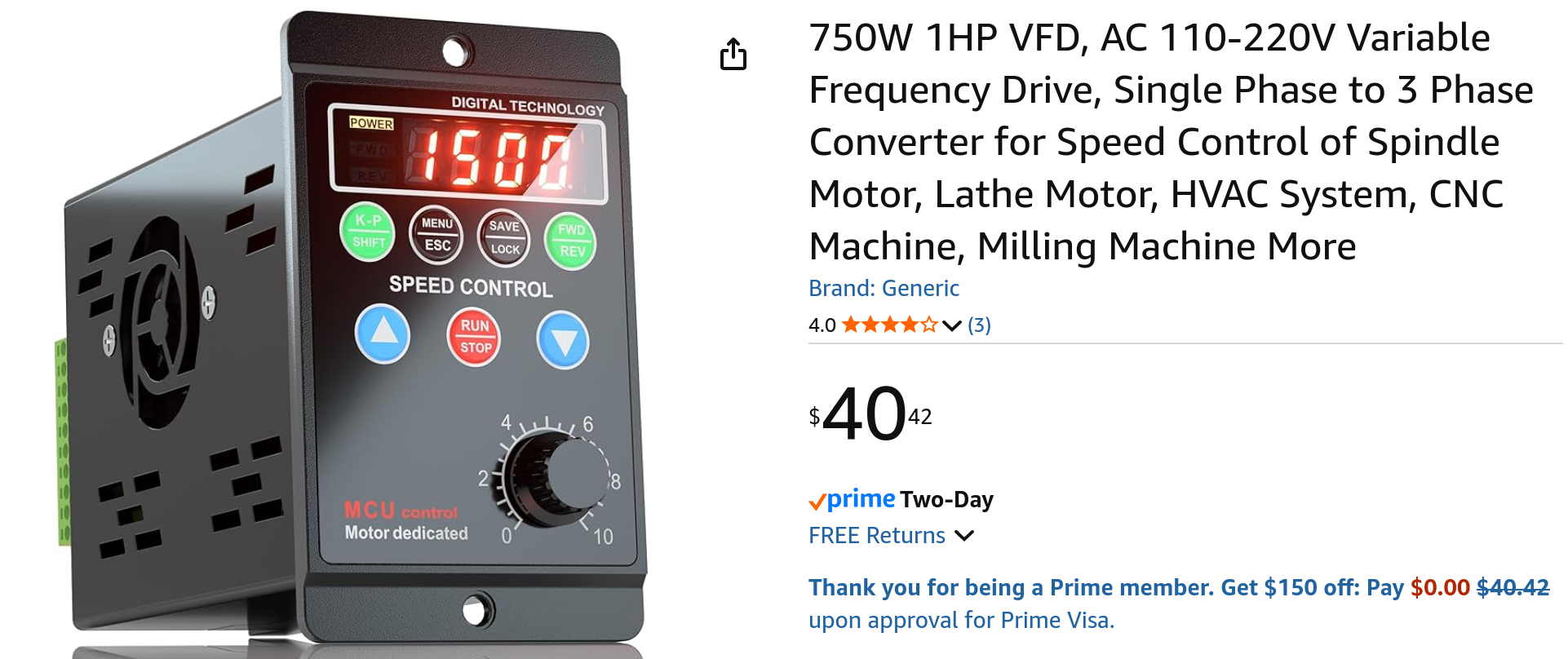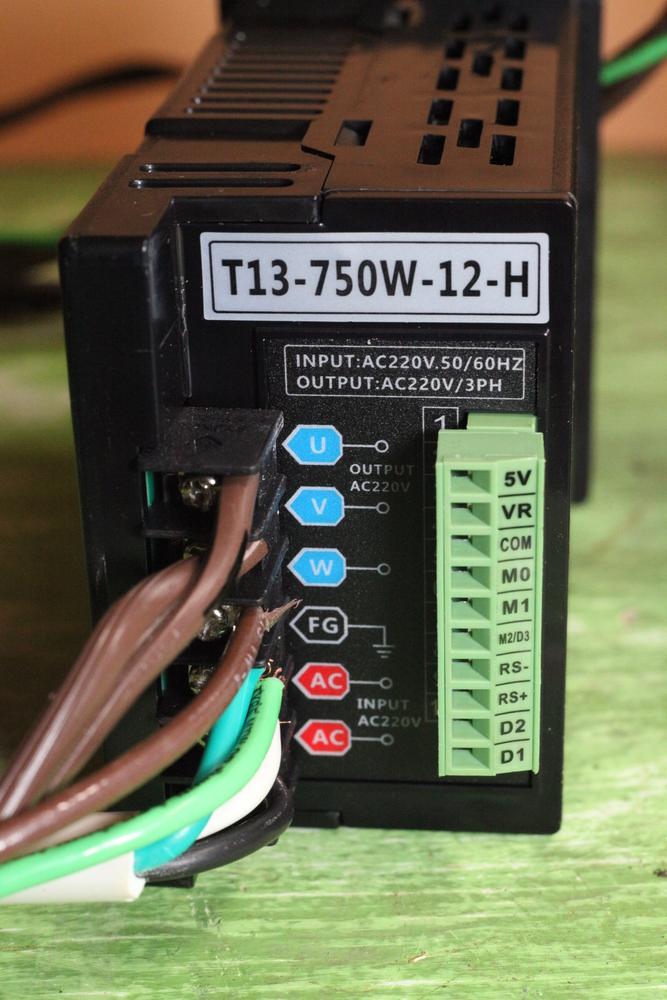-
Posts
420 -
Joined
-
Last visited
Content Type
Profiles
Forums
Events
Blogs
Gallery
Everything posted by friquant
-
That spring likely slides around either the outer presser foot bar or the inner presser foot bar. On my machine, these two bars are different diameters, so that will tell you which one it goes around. Looks too short to be the one that drops in the top for your pressure adjustment. By any chance do you have pictures from before and after? Perhaps someone with a 335 can post a picture to show where the springs belong.
-
I opened up the VFD and disconnected the fan. The VFD has thermal protection, currently set to trigger at 90 degrees C, so I'm not worried about overheating it with the low duty cycle I'll be putting it through. Here's a video to show the sound level without the fan vfd-sounds-new-bearings-no-fan__small.mp4
-
Here's how to replace the bearing on the gearbox end of the motor shaft. There is a big circlip on the motor side of the gearbox. (There will be a photo later) Make sure you remove that before you do any pounding This first image shows the gearbox after you remove the four cap bolts and pull the cap off. This model has two dimples in the shaft to mushroom it out to keep it on. I moved the dimples back inline with the shaft using punch, then used a 1/4 inch drive socket extension and a sledgehammer to drive the shaft out. Here is the bearing that needed replacement the most. Note the large circlip behind it---that's the one you have to remove before you do any pounding. Now that the bearing is out of the gearbox, I used a 3-jaw puller. By the way, notice the paint on this one is white. This is a second gearmotor (same make and model) from the same ebay seller. This time better paint, but still needed a new bearing. I replaced both bearings on the motor shaft, both are size 6203. I did not replace any bearings at the gearbox output shaft. They turn smoothly already, and they get a lot less revolutions than the motor bearings! Good news is, this motor runs semi-quietly with the new bearings. (Makes an oompah sound like you might imagine used as a movie sound effect in an eerie movie) I'll be replacing the motor shaft bearings on the other motor soon.
-

Adler 205-370 - help an old man who screwed up
friquant replied to councilman24's topic in Leather Sewing Machines
Nice work! I aspire to own a machine like this someday, so tucking these notes away for future me 😀 -
Hi Romana, What material are you sewing? Does the machine make good stitches? Presser Foot Pressure On my machines I typically reduce the force of the presser foot because it's uncomfortable to lift the presser foot otherwise. But I'm stitching lightweight materials predominantly. @Wizcrafts is often reminding us that the presser foot must not lift off the table when the thread take up lever tugs on the top thread to complete the stitch. In some cases (stitching on corrugated plastic signs when i do not want to crush the signs) I remove the main pressure spring altogether. But for thinner material I have to put the spring back in or the feet don't contact the cylinder bed well enough. Lubrication In the case of the Pfaff 545, I needed to add a healthy dose of grease to the plates on the back of the machine where the knee lift connects---otherwise it was noisy and hard to move the knee lift. Comfort Grips Also in the case of the Pfaff 545, the hand lever for lifting the presser feet is so tiny and awkward that I wrapped some foam around it and held it in place with duct tape. This made it somewhat more comfortable to lift by hand. (The knee lift was much better after greasing)
-

Option D : 3-Phase AC Gearmotor with VFD (Variable Frequency Drive)
friquant posted a blog entry in State of the Servo Motor
Option D : 3-Phase AC Gearmotor with VFD See the parent article: Choosing a Motor The lesser known of motor options is the 3-phase AC Gearmotor with VFD (variable frequency drive). This option gives excellent driveability (does what you ask with no surprises) but requires a fair amount of setup. 1. Interesting Posts about 3-Phase AC Gearmotors with VFD The search bar on the forum does not support three letter words like “awl” or “VFD”. So you will have to use an external search engine to find posts on VFD. Try this search for example: https://www.google.com/search?q=vfd+site%3Aleatherworker.net Here are some forum posts to get you started: GerryR: Description of his VFD setup Tigweldor: How to build a portable VFD GerryR: Adapting a 3-phase clutch motor for use with VFD GerryR: How to get started with VFD TinkerTailor: "The sewing world has not embraced vfd like the machinist world it seems, though in theory it is likely the best way to go for a slow moving leather stitcher." friquant: Introduction to Gearmotors and VFD 2. What is an AC Motor Specifically, we’re talking about AC induction motors. Think table saw, bench grinder, garbage disposal, air conditioner fan. In typical use, an AC motor runs at a constant speed. For example, when you turn on the table saw or bench grinder you hear the motor goes WhOOOOSH for a couple seconds as it gets up to speed. Once at speed, it stays at about that same speed. (A little less under load than with no load). AC induction motors can be single phase or 3-phase. (We want 3-phase for use with a VFD.) The speed the motor turns depends on the frequency of the power source and on how many electromagnetic poles the motor has. As an example, a four-pole AC induction motor typically has a speed around 1400 rpm when fed 60Hz power from the wall. 3. What is a Gearmotor A gearmotor means a motor with a gear reducer added at the end. It looks more or less like a single unit. The gear reduction can be a little bit (like 3:1, which can also be written “3k”) or it can be a lot (like 200:1, which can also be written as “200k”). 2.1 Shopping for an AC Gearmotor Choose a motor size that is suitable. 100W (1/8 horsepower) to 400W (½ horsepower) is probably adequate Make sure your AC gearmotor is 3-phase Make sure your AC gearmotor can run on 220V power. (Some can run on either 220V or 380V) Choose a gear reduction that is suitable. (3:1, 5:1, 10:1 are probably the most suitable) Get one that mounts horizontally (sometimes called a “foot mount”) 4. What is a VFD (Variable Frequency Drive) A VFD (Variable Frequency Drive) is an electrical device that outputs 3-phase power (in the range of 220V) at whatever frequency you choose. (0Hz - 100Hz is typical). 4.1 Why do we want a VFD The speed of an AC induction motor is proportional to the frequency of the power source. The VFD allows us to send whatever frequency we want to the motor, between 0Hz and 100Hz, and the motor speed will change accordingly. 4.2 Shopping for a VFD When shopping for a VFD, make sure you get one that accepts as input power whatever power you have conveniently available. (110V single phase input is a common option.) Note VFDs will usually have a cooling fan that turns on when the VFD is engaged. Mine is louder than I would prefer. I may look for another one with a quieter fan. 4.3 Setting up your VFD When you first get your VFD you can test it out with your motor by using the knob on the front of the VFD to control the frequency. The motor will not move at all when the knob is set to 0Hz, but the hand wheel will still turn freely. Once you move the knob above 0Hz, around 1Hz you will start to see very slow movement in the motor. Turn the knob up high and it will go full speed. For actual use with a sewing machine, you will want an external potentiometer to tell the VFD how fast to go. Buying a TIG pedal is a cost-effective way to get a pedal with two potentiometers and an inline switch so that you can both engage the VFD and drive at whatever speed you want. Here is the TIG pedal I bought. Digging into the user manual for your VFD you will be able to find options for setting the minimum speed, maximum speed, and for limiting the acceleration. 5. Is a 3-Phase AC Gearmotor with VFD Right for Me Choose a 3-Phase AC Gearmotor if: You want the absolute best in terms of driveability. (Does what you want with no surprises) If you want the consistency of the needle always penetrating the fabric, without need to “get a run at it” You want full configurability of how fast your motor goes, and when. (Very slow start available!) You are comfortable wiring electrical equipment You understand basic electronic components such as potentiometers and switches You are comfortable reading technical manuals (The VFD will come with a manual) You are comfortable configuring electronic devices through their menus You want gear reduction without needing extra belts You are willing to buy a pulley separately that fits the gearmotor output shaft and your belt of choice You are willing to mount the motor yourself and come up with your own belt tensioning system -

Maintanence Question on Juki 1508 NH
friquant replied to MarineBozo's topic in Leather Sewing Machines
On my pfaff 545 the knee lift was very hard to engage until I greased the area on the back of the machine where the plate slides against the body (and pushes on the rod to release the tension). I had already oiled everything, or so I thought. But when I finally removed that little piece and greased behind it, the knee lift became easy to use. Perhaps it is that there are parts underneath that oil doesn't get to easily. Or maybe the grease is just better at lubricating things that move slowly like a knee lift. Anyway, that's the first place I would look. To go along with that, I would remove the thread tension assembly from the front of the machine, pull out the actuating rod that goes from the back to the front of the machine, and make sure the back end of that is greased. -
Hook timing...what a drag! You remove some parts, insert a brand new needle, then get out the calipers and measure a tiny rise of the needle bar past bottom dead center. Afterwards, if the machine does not sew well, you repeat the process and hope for better results. That's why I'm going to start measuring hook timing another way---at least on my vertical hook-shaft machines. I'm going to start measuring degrees of hook rotation. Protractor I'll set up my axes like this: 0 degrees: when the hook shoulder is farthest from the user 90 degrees: when the hook shoulder reaches the apex of the hook's journey around the bobbin I'll print this protractor and tape it to the machine bed. Note the origin/center of the protractor is at the center of the hook/bobbin. Note in the photo above, the white top thread is stretched between the throat plate hole and what I've been calling the hook "shoulder". I'll rotate the hand wheel to where the take-up lever is at is lowest point. Then I'll take a measurement of the hook angle from the center of the hook to the hook shoulder. (I chose the hook shoulder because it is the part that actually drags the thread around the bobbin, and it is easy to see from the top.) If you click into this image you can see that the edge of the ruler/square crosses the center of the hook and crosses the hook shoulder where the bit of white thread is peeking out. Note this photo shows a 39 degree measurement. What This Measurement Style Provides: Easy to measure hook timing without removing anything but the bobbin cover plate Easy to visualize where the hook is in its cycle in relation to where the thread take-up lever is in its cycle Easy to make generalizations (I hope) about certain hook timing angles producing certain behavior/symptoms across lots of different machines The timing angle is the same regardless of what stitch length is selected The larger the timing angle, the more advanced the hook timing. (Note with the old/conventional measurement system, larger numbers mean the hook timing is less advanced.) The timing angle is the same regardless of how much the hook point is worn Background / Theory: The hook's job is to grab the top thread and drag it around the bobbin. As the hook shoulder rounds the apex of its path (goes around the right-most edge of the bobbin), that is the farthest that the thread gets dragged through the needle before the thread take-up lever pulls the thread back the other way. The hook shoulder going around the right-most edge of the bobbin must coincide roughly with the thread take-up lever being at its lowest point, otherwise the thread will be tight and the hand wheel hard to turn as the hook drags the thread round the bobbin. Some Data Points and Corresponding Behavior I was working on dialing in the timing on an old Singer, and to learn the machine better (and develop my skills) I was purposefully doing it without referring to a manual. Here are the timing angles on the left, and a description of the corresponding behavior on the right. 2° Top thread tight and grabby as it rounds bobbin 13° Top thread tight and grabby as it rounds bobbin 20° Top thread tight and grabby as it rounds bobbin 44° Most of rounding bobbin is easy...but snags just a bit on the hump by the bobbin tension spring 46° Easy to round bobbin. Good clearance between nearly-formed loop and hook 51° Easy to round bobbin. Minimal clearance between nearly-formed loop and hook 70° Very easy to round bobbin. Negative clearance between nearly-formed loop and hook. (The hook stabs into the nearly-formed loop and jams the machine.) In this round of measurements, the 46 degree setting was my favorite. (I did not get more measurements between 30 degrees and 44 degrees because I was having trouble getting the worm gear slid into position.) Making Generalizations By trying out various timing angles, I was able to observe certain behaviors and put them on my mental map of what causes those behaviors. (And can hopefully fix some of the tendencies from the "70°" row that I've been having on a different machine!) Hope this is useful to someone wanting to understand not just how to set hook timing by the book, but how to react to certain (mis)behaviours, and possibly how to design a sewing machine 😀
-
I spent a day with a binder on my pfaff-545 and could not get the bottom and top sides to be even. I conjectured that to get them even the entrance runway (the zig zag of wire) would need to be horizontal, whereas mine was canted upwards to clear the flatbed. My best plan at the time was to stitch from the wrong side of the fabric, since the bottom of the binder always had less coverage than the top. That way the stitches on the right side of the fabric could be close and tidy to the edge of the binding. I bought two binding attachments with my JL 341, but have not used them. When I ordered them they were specific about asking what kind of tape I wanted to use---both its width and its thickness.
-

How to Subscribe to Everything in a Single Forum
friquant replied to friquant's topic in Computer Help
That does seem to be the pattern for the other missing notifications as well. I'll figure out a game plan for those 🍹 -
Is following a subforum expected to be reliable? A month or so ago I set myself as following the Leather Sewing Machines subforum. Since then I've only been reading things I see notifications for, which I assumed would be all the new posts in that subforum, plus replies to things I've replied to. Today I stumbled upon some new posts in the same subforum that I had not seen and that did not show up in my notifications. Example post that I did not receive a notification for: https://leatherworker.net/forum/topic/131587-binding-attachment-from-china/ That was posted on Thursday. Here is a screenshot of my notifications for thursday @Johanna for visibility
-
I don't have any experiece with a Pearson #6, but if you can post some videos of what you're seeing maybe someone here can make sense of it. In general if it picks up the thread when there is no material under the foot, but doesn't pick up the thread when there IS material under the foot, I would think it's a timing issue. Just speculating. On my vertical-shaft machine I can take the cover off the bobbin and watch the hook go around and see it drag the thread around the bobbin. You may be able to do something similar with your setup to figure out what/when it's missing.
-
P03 is probably needle-down position (mean how far the handwheel turns from needle-up position to needle-down position) P10 is supposedly for breaking in the machine. I forget where I read that. This Stitchman Servo: The missing manual may give you ideas about some of the others.
-
The motor howls---I suspect it's a bearing inside the gearbox that has a pitted race. I have not been able to get the front cover off the gearbox. Next time I'll tap it with a sledgehammer to knock it loose. The VFD has a noisy fan too, but the motor howl is the bigger problem.
-
Thanks! I've been enjoying it 🤠 None so far. My duty cycle is quite low in general as I'm typically spending much more time thinking about sewing and planning the design than I am actually stitching. The only instances where I can see a good use for going ultra slow is at the start of a seam (when I'm scrambling to make sure I've got the thread held down while also driving one-handed), and at a corner or end of a seam when I might slow down to make sure I bury the needle when I let off the gas. The middle sections, especially of straight seams, warrant higher speed else one gets bored. I conjecture that a few seconds of ultra-low speed at the beginning and end of each seam, even if they do cause extra heat (I'm unclear on this point) won't cause enough extra heat in those few seconds to cause any trouble---the heat will be absorbed by the mass. As far as what could potentially overheat, and how to measure & test that, I'm open to suggestions. VFD This VFD has a temperature sensor for itself, and you can specify what temperature is too hot and it will disable at that temperature. Motor This motor does not have a temperature sensor that I know of. I could imagine nesting a thermistor between the coils of the stator and running the thermistor wires out through the electrical box along with the power wires. I have not adjusted the volts-per-hertz settings at all yet, but that's worthy of testing out. I wish this VFD had a setting for overall reducing the amount of current (torque) going to the motor, but I haven't found a setting for that yet.
-
Got it cleaned and painted Here it is set up temporarily with the Singer 31-15 And a video of how it operates using the TIG pedal's contact switch and potentiometer to activate the VFD when you step on it. vfd-intro.mp4 Would like to find a reliable, inexpensive source for these gearmotors so we can set up a recipe or parts list for anyone who wants to go this route.
-
I recently found this same cooling design on an industrial motor. In this photo, the cover (far right) has been removed. So I asked my favorite AI about it, and I found this page: https://en.wikipedia.org/wiki/TEFC_motor
-

Singer 132k6 capabilitues and upgrades
friquant replied to Ed Neil's topic in Leather Sewing Machines
Re: Clutch motor It's a 110V motor. It's normal/fine for switches and capacitors to be rated for higher voltage that the actual use case. But even if you did want to use a clutch motor, this is not the one to use because it's a 2-pole motor (3500rpm) instead of the 4-pole variety which are only 1750rpm. Good move on the digital servo. Is it a cylindrical shaft 15mm diameter? If so, you can get a 45mm pulley for that here: https://www.ebay.com/itm/376135081840 which will slow it down considerably. Re: Belt slipping I would buy a new belt. The belt looks all dried out (less grip) and looks to be too narrow for that pulley. V-belts need to be pressing against the walls of the pulley to get the best grip. I've been buying belts like this one: https://www.amazon.com/dp/B0BK1FQHRR but I suspect that a 3/8" automotive (rubber on the outside) belt would be the grippiest. -
Nice photos!! You can check whether bobbin is loaded properly before making any stitches. Install the bobbin and bobbin case cap. Put the latch down (and make sure no thread under the latch!) Bring up the bobbin thread Pull the bobbin thread for a few inches. You should feel a gentle resistance the whole time you are pulling. If it snags, something is not right.
-

Singer 132k6 capabilitues and upgrades
friquant replied to Ed Neil's topic in Leather Sewing Machines
@Wizcrafts blogged about the 132k6 in his My history with leather sewing machines blog -

Singer 132k6 capabilitues and upgrades
friquant replied to Ed Neil's topic in Leather Sewing Machines
Can you send us pictures of your current setup? (Motor, pulley, belt, machine) Also photos of your old motor, control box, and nameplate if it has one? (If you want help diagnosing the old motor, that is) New leather belt? Old leather belt? I like having my belt tension set just high enough to go through my thickest material, that way I'm less likely to break things. My belt is not very grippy, but I'm considering getting a regular rubber automotive belt instead of these cloth-covered belts I've been using. Not sure what other folks are using for belts. -
To find out what is binding up, you can turn the handwheel very slowly and pay attention to which part of the circle it binds at. Binding typically means something is trying to move farther than there is space to move. You can start taking inspection covers off to see the linkages that are at work. I've had a machine bind when it tried to lift the needle bar too high, and the needle bar ran into the head unit. Or when the latch opener tried to open wider than there was room for. Not sure what you'll find on this machine, but if you start exploring hopefully you can find some clues. While you're at it, you can oil the linkages 😀
-
Today I was able to bench test my first 3-phase AC gearmotor running on VFD. It's a foot-mounted Sew-Eurodrive 1-horsepower with 4.5:1 gear ratio. Gearmotor A four-pole AC motor typically has a speed around 1500 rpm when fed 60Hz power from the wall. With the 4.5:1 gear reduction, that puts us around 330rpm with wall power (60Hz). So long as the AC motor is 3-phase, we can add a VFD in the mix to control the frequency of the power going to the motor. And voilà, we have a motor that can go anywhere from 0rpm up to 330rpm. At least that's the theory I've been reading for the past few weeks...I hadn't seen any of this in action until today. This ragamuffin came to me by way of ebay. Here is the original listing. I'll include a screenshot of the listing because these listings go away eventually. This motor is bigger than I needed. 400 watts (1/2 horsepower) or maybe even 100 Watts (1/8 horsepower) would suffice. But this one I found for a song, only $65 after shipping. I did verify that it was actually 3-Phase before buying. (See the "3PH" in the upper right corner of the motor nameplate) The box arrived a few days later. It was packed cozily in cardboard and foam. The outside of the motor is gritty. Perhaps it's been running in a moist environment. The ad says it was taken from a running system. I'd like to clean it up and paint it, but I want to see it run first.. The wiring was set up for 380V, so I reconfigured according to the diagram for the 220V that my VFD will output. (My VFD takes 110V single phase as input, and outputs 3-phase in the range of 220V.) Here is before and after, note the copper strips have been repositioned under the nuts to effect the wiring change. VFD The VFD (variable frequency drive) I've actually had for a couple weeks while I've been looking for motors. But I've never owned any 3-phase equipment so had no way to really test the VFD, hence the excitement when the gritty box finally arrived. 🤪 Here is a link to the VFD I'm using: https://www.amazon.com/dp/B0D53Z7RZ5 And a screenshot: Here's what the back of the VFD looks like. The two red "AC" labels are for neutral and 110V single phase input. FG is ground, connecting both to ground in the wall outlet and to the ground on the motor. The blue U, V, W are the 3-phase outputs which the VFD can control to be any frequency from 0Hz up to I think 100Hz, which is how the VFD accomplishes speed control on an AC motor which would otherwise be fixed speed. The green strip on the right is for low voltage input/output. One of them can be used with an external potentiometer to set the frequency. I've ordered a TIG pedal for this but it has not arrived yet---So today we'll use the built-in potentiometer/knob on the front of the VFD to control our speed. Bench Test Here we are on the bench: And a video gearmotor-voice-01.mp4 Many thanks to @GerryR who has fielded a LOT of questions from me as I've been pursuing this journey.
-

Anyone taken a cheap servo motor apart?
friquant replied to AlZilla's topic in Leather Sewing Machines
When I was in there, I found three hall sensors in position to read the permanent magnets of the rotor as they go by. I should have worn gloves when I put it back together...those magnets are vicious, and I got pinched.


